There are a few posters out there for Khufu and his majestic pyramid and ship, check out these for a starter:
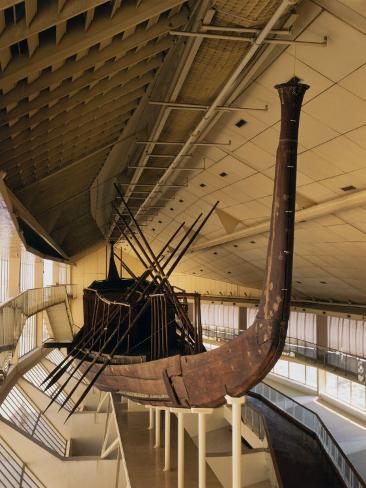



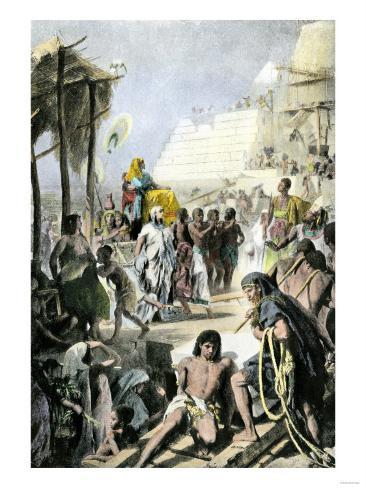

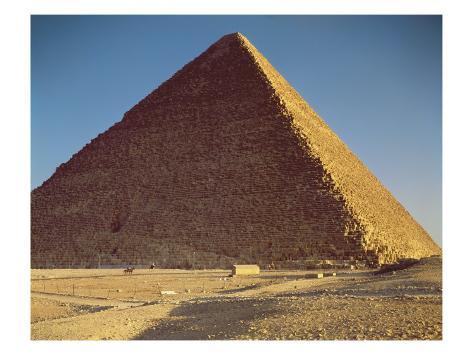



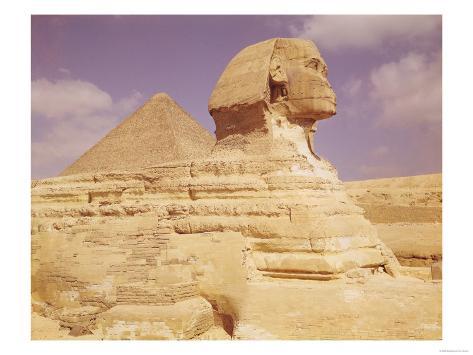

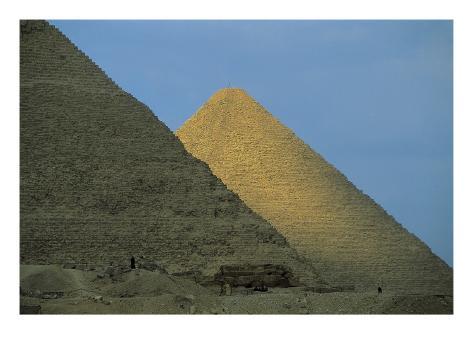

Family Tree of Khufu / Cheops
Birth name: Khufu (Protected by Khnum) AKA Cheops/Kheops (Greek). Suphis I (Manetho)
Father: Snefru
Mother: Hetepheres I
: 1 Unknown queen 2 Meritates 3 Henutsen 4 Unknown Queen
Sons: 1 Djedefre 2 Kawab 3 Khafre (Chephren) 4 Djedfhor 5 Banefre 6 Khufukaef
Daughters: 1 Hetepheres II 2 Meresankh II 3 Khamerernebty I
Burial: The Great Pyramid, Giza
The Life of Khufu / Cheops
The ancient authors through whom Manetho's works survive were all agreed that the third king of the 4th Dynasty was "Suphis, the builder of the Great Pyramid, which Herodotus says was built by Cheops. Suphis convinced a contempt for the gods, but repenting of this, he composed the Sacred Books, which the Egyptians hold in high esteem". "Suphis is better known by the Greek form of Cheops and the Egyptian form Khufu. It is curious that Khufu should be placed third in line; there do not appear to be any other records of an intervening pharaoh between him and his father Snefru. The reference to his composing Sacred Book is intriguing - these do not seem to have survived in later literature although Khufu's character was severely blackened by later chronicler and strongly contrasted with the lives of his successors Chephren (Khafre) and Mycerinus (Menkaure).
Like his father, Khufu probably reigned for about 23 or 24 years, and he too seems to have initiated military expeditions to the Sinai peninsula. Rock inscriptions in the Wadi Maghara record the presence of his troops in this region, no doubt for the dual purposes of keeping the Bedouin in check and exploiting the turquoise deposits there. A now very faint inscription on a large boulder on the island of Elephantine at Aswan also indicates that the king had interests in the far south of the country - quarrying the fine Aswan red granite.
The Great Pyramid of Khufu / Cheops Pyramid
Originally 481 ft or 146.6 m high (now only 451 ft or 137.5 m, having lost its top 30 ft) it was until the 19th century AD the tallest man-made building in the world -a proud record held by an ancient Egyptian architect for four and a half thousand years.
Khufu's Pyramid's Vital Statistics:
Original height: 481 ft (146.6 m)
Present height: 451 ft (137.5 m)
Angle of slope: 51°52'
 Number of blocks used to build it: somewhere in the region of 2,300,000 seperate blocks in the usual figure suggested, each averaging about 2.5 tons is weight with a maximum of 15 tons. While his officers climbed to he summit in July 1798, Napoleon apparently sat in its shadow and calculated that there was enough stone used in the three pyramids of Giza to be able to build a wall around France, 1 ft (0.3 m) wide and 12 ft (3.7 m) high. The mathematician, Gaspard Monge, who accompanied the French savants to Egypt, is said to have confirmed Napoleon's calculation.
Number of blocks used to build it: somewhere in the region of 2,300,000 seperate blocks in the usual figure suggested, each averaging about 2.5 tons is weight with a maximum of 15 tons. While his officers climbed to he summit in July 1798, Napoleon apparently sat in its shadow and calculated that there was enough stone used in the three pyramids of Giza to be able to build a wall around France, 1 ft (0.3 m) wide and 12 ft (3.7 m) high. The mathematician, Gaspard Monge, who accompanied the French savants to Egypt, is said to have confirmed Napoleon's calculation.
(Right) Statue of Hemon, Khufu's master builder.
The eyes have been hacked out by robbers, and restored.
Click on the picture to enlarge.
Now in Hildesheim Museum
The royal ship of Khufu / Cheops:
Khufu's Misconception
Herodotus believed that Khufu was a harsh king who put his citizens into hard labor and slavery. No surprise, since the Great Pyramid of Giza was the largest structure on earth at the time of Herodotus, and it was so hard for him to believe that a king could have paid workers to build such a giant structure. After all, enslaving citizens was pretty standard in the whole world.







Family Tree of Khufu / Cheops
Birth name: Khufu (Protected by Khnum) AKA Cheops/Kheops (Greek). Suphis I (Manetho)
Father: Snefru
Mother: Hetepheres I
: 1 Unknown queen 2 Meritates 3 Henutsen 4 Unknown Queen
Sons: 1 Djedefre 2 Kawab 3 Khafre (Chephren) 4 Djedfhor 5 Banefre 6 Khufukaef
Daughters: 1 Hetepheres II 2 Meresankh II 3 Khamerernebty I
Burial: The Great Pyramid, Giza
The Life of Khufu / Cheops
The ancient authors through whom Manetho's works survive were all agreed that the third king of the 4th Dynasty was "Suphis, the builder of the Great Pyramid, which Herodotus says was built by Cheops. Suphis convinced a contempt for the gods, but repenting of this, he composed the Sacred Books, which the Egyptians hold in high esteem". "Suphis is better known by the Greek form of Cheops and the Egyptian form Khufu. It is curious that Khufu should be placed third in line; there do not appear to be any other records of an intervening pharaoh between him and his father Snefru. The reference to his composing Sacred Book is intriguing - these do not seem to have survived in later literature although Khufu's character was severely blackened by later chronicler and strongly contrasted with the lives of his successors Chephren (Khafre) and Mycerinus (Menkaure).
Like his father, Khufu probably reigned for about 23 or 24 years, and he too seems to have initiated military expeditions to the Sinai peninsula. Rock inscriptions in the Wadi Maghara record the presence of his troops in this region, no doubt for the dual purposes of keeping the Bedouin in check and exploiting the turquoise deposits there. A now very faint inscription on a large boulder on the island of Elephantine at Aswan also indicates that the king had interests in the far south of the country - quarrying the fine Aswan red granite.
The Great Pyramid of Khufu / Cheops Pyramid
Khufu's greatest achievement was the creation of a monument that was to be recognized as the first of the Seven Wonders of the Ancient World, and the only one now standing: the Great Pyramid on the Giza plateau.
 |
| Pyramid of Khufu (Cheops Pyramid) |
It is not known why Khufu should have turned for all its magnificence the Great Pyramid is still a puzzle. Herodotus was quoted some apocryphal figures by the priests: it took 10 years to build the causeway from the valley temple to the mortuary temple, 20 years to build the pyramid itself and the whole cost was in the region of 1600 silver talents (according to an inscription pointed out to him on the side), or just over £5 million/£43.17 million at present scrap silver prices.
Moreover, we do not know exactly how it was built. Theories about this vary, from the use of a long ramp stretching out into the desert which was continually lengthened and heightened as the pyramid rose higher, to a ramp that rose as it wound round the pyramid face following each course upwards. Neither is very satisfactory and each is rather impractical in one way or another. Herodotus said that the structure had been built as a series of terraces, raising blocks on all four sides simultaneously with the use of 'contrivances made of short timbers'. This approach was tested with some success by the late Peter Hodges, a master builder, using short lengths of timber with a metal-shod foot, and it is certainly more convincing than the other theories.
The internal layout indicates at least two changes in plan during construction. Initially there was to have been a burial chamber deep beneath the surface of the plateau; this plan was then altered to incorporate instead a small chamber, now erroneously known as the Queen's Chamber (and unfinished) within the pyramid bulk and about 50 ft (15.2 m) above ground level. Exploration in 1993 by a small robot remote-controlled camera up the south 'air' tunnel from the Queen's Chamber has revealed a small door secured by metal bolts. There is no question of access because the door is so tiny, the tunnel being only 8 inches (20.25 cm) square. The results of further investigation are eagerly awaited. The final change was for the construction of the magnificent Grand Gallery, 28 ft (8.5 m) high and closed by a corbeled roof, which led upwards to a horizontal passage that entered the King's Chamber the heart of the pyramid. Here, at the west end of the chamber, was placed a large granite sarcophagus, cut from a single block of Aswan granite. The sarcophagus must have been put in position before chamber was roofed by nine flat slabs of granite (each with an average weight of almost 45 tons), because it is about an inch too wide to through the entrance to the Ascending Corridor - an early example 'built-in' furniture.
The exterior of the pyramid was cased with shining white Tura lime-stone, which was laid, as Herodotus rightly said, from the top downwards. This was largely robbed in the Middle Ages to build medieval Cairo. Of the great limestone mortuary temple (171 x 132 ft, 52 x 40 m) that stood before the pyramid's east face, nothing now remains except its black basalt floor. The valley temple that stood at the foot of the pyramid causeway has disappeared under the Arab village, although parts of it were observed in 1991 when new sewerage was being laid.
Around the Great Pyramid, principally on the west side, were located the tombs of the courtiers, who hoped to serve their king in death just as they had in life. On the east side are three subsidiary pyramids of Khufu's queens. Legend had it, as recounted by Herodotus, that the central pyramid, 150 ft (46 m) square, was a product of the enterprise of of Khufu's daughters, whom he had placed in a brothel in order to raise more revenue for building the Great Pyramid. In addition to payment, the princess also asked each of her clients for a block of stone, which she used to build her own pyramid. Needless to say, there is no evidence to confirm the story, although the pyramid does appear to be that of a half-sister of Khufu. The first pyramid probably belonged to his full sister-wife, and the third to another half-sister, Queen Henutsen.
Two remarkable discoveries relating to Khufu have been made in the vicinity of his pyramid: the first, found in 1925 on the east side close to the causeway, was the tomb of his mother, Queen Hetepheres; and the second, uncovered in 1954 close to the south face, was that of an intact wooden ship.
Around the Great Pyramid, principally on the west side, were located the tombs of the courtiers, who hoped to serve their king in death just as they had in life. On the east side are three subsidiary pyramids of Khufu's queens. Legend had it, as recounted by Herodotus, that the central pyramid, 150 ft (46 m) square, was a product of the enterprise of of Khufu's daughters, whom he had placed in a brothel in order to raise more revenue for building the Great Pyramid. In addition to payment, the princess also asked each of her clients for a block of stone, which she used to build her own pyramid. Needless to say, there is no evidence to confirm the story, although the pyramid does appear to be that of a half-sister of Khufu. The first pyramid probably belonged to his full sister-wife, and the third to another half-sister, Queen Henutsen.
Two remarkable discoveries relating to Khufu have been made in the vicinity of his pyramid: the first, found in 1925 on the east side close to the causeway, was the tomb of his mother, Queen Hetepheres; and the second, uncovered in 1954 close to the south face, was that of an intact wooden ship.
Khufu's Pyramid's Vital Statistics:
Original height: 481 ft (146.6 m)
Present height: 451 ft (137.5 m)
Angle of slope: 51°52'
Orientation: the four sides are orientated to the four cardinal points with only the minutest of errors.
Length of sides: basically 755 ft (230 m), with the greatest difference between the longest and shortest of only 8 in (20.3 cm).
Ground surface area: 13 acres, which, it has been calculated, could accommodate St Peter's in Rome, Westminster Abbey and St Paul's Cathedral in London, and the cathedrals of Milan and Florence. It is known that there rises within the mass of the pyramid a huge natural rock of unknown dimensions.
 Number of blocks used to build it: somewhere in the region of 2,300,000 seperate blocks in the usual figure suggested, each averaging about 2.5 tons is weight with a maximum of 15 tons. While his officers climbed to he summit in July 1798, Napoleon apparently sat in its shadow and calculated that there was enough stone used in the three pyramids of Giza to be able to build a wall around France, 1 ft (0.3 m) wide and 12 ft (3.7 m) high. The mathematician, Gaspard Monge, who accompanied the French savants to Egypt, is said to have confirmed Napoleon's calculation.
Number of blocks used to build it: somewhere in the region of 2,300,000 seperate blocks in the usual figure suggested, each averaging about 2.5 tons is weight with a maximum of 15 tons. While his officers climbed to he summit in July 1798, Napoleon apparently sat in its shadow and calculated that there was enough stone used in the three pyramids of Giza to be able to build a wall around France, 1 ft (0.3 m) wide and 12 ft (3.7 m) high. The mathematician, Gaspard Monge, who accompanied the French savants to Egypt, is said to have confirmed Napoleon's calculation.(Right) Statue of Hemon, Khufu's master builder.
The eyes have been hacked out by robbers, and restored.
Click on the picture to enlarge.
Now in Hildesheim Museum
The royal ship of Khufu / Cheops:
During clearance work close to the south side of the Great pyramid in May 1954, Kamal el-Mallakh found a series of 41 large blocking stones, whith an average weight of 18 tons each, which had hermeticaly sealed a 101-ft (30.8-m) long ship of cedar wood. Too long for the pit intended for it, it had been carefully dismantled into 650 parts comprising 1224 pieces. After many years of patient restoration work by Hag Ahmed Youssef Moustafa (who had also been responsible for the restoration of Hetepheres' furniture), the ship was presented to the world in March 1982 in a specially designed museum which incorporated the pit in which it had lain for 4500 years. Not all the problems posed in conserving the ship have yet been solved by the Egyptian Antiquities Organisation; until they are, the opening of a second sealed pit discovered near the first will be postponed. Recent tests have indicated that it also contains a ship, but not in such good condition. It is a remarkable quirk of fate that for all the grandeur of Khufu's pyramid, his funeral boat, and the splendid style of his mother's funerary furnishings, there remains only one tiny portrait of the king himself, found by Flinders Petrie in the old temple of Osiris at Abydos in 1903. In a curious inverse ratio we find that the smallest statue represents the builder of the greatest pyramid, while some of the finest multiple statues extant from the Old Kingdom represent the builder of the smallest of the Giza pyramids, Menkaure (fifth ruler of the 4th Dynasty).
Khufu's Misconception
Herodotus believed that Khufu was a harsh king who put his citizens into hard labor and slavery. No surprise, since the Great Pyramid of Giza was the largest structure on earth at the time of Herodotus, and it was so hard for him to believe that a king could have paid workers to build such a giant structure. After all, enslaving citizens was pretty standard in the whole world.
Today we know by evidence that this giant pyramid was built by paid laborers who worked by their own will and received salary for the job they did. This evidence leaves Herodotus' beliefs in great doubts, which is mostly now believed to have been a misconception.



